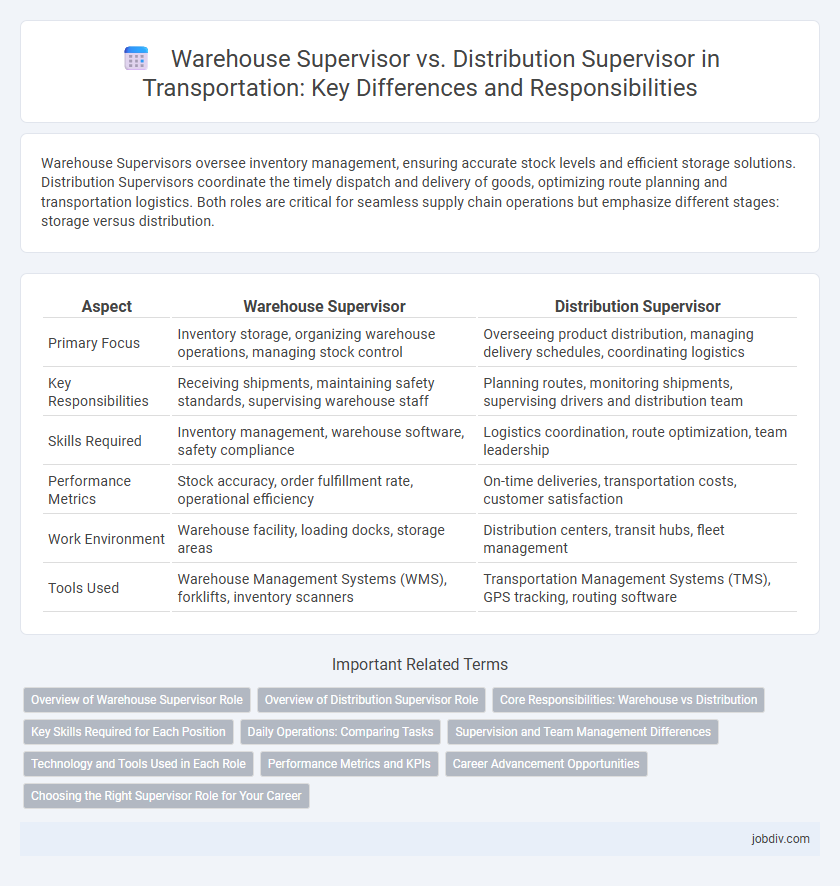Warehouse Supervisors oversee inventory management, ensuring accurate stock levels and efficient storage solutions. Distribution Supervisors coordinate the timely dispatch and delivery of goods, optimizing route planning and transportation logistics. Both roles are critical for seamless supply chain operations but emphasize different stages: storage versus distribution.
Table of Comparison
| Aspect | Warehouse Supervisor | Distribution Supervisor |
|---|---|---|
| Primary Focus | Inventory storage, organizing warehouse operations, managing stock control | Overseeing product distribution, managing delivery schedules, coordinating logistics |
| Key Responsibilities | Receiving shipments, maintaining safety standards, supervising warehouse staff | Planning routes, monitoring shipments, supervising drivers and distribution team |
| Skills Required | Inventory management, warehouse software, safety compliance | Logistics coordination, route optimization, team leadership |
| Performance Metrics | Stock accuracy, order fulfillment rate, operational efficiency | On-time deliveries, transportation costs, customer satisfaction |
| Work Environment | Warehouse facility, loading docks, storage areas | Distribution centers, transit hubs, fleet management |
| Tools Used | Warehouse Management Systems (WMS), forklifts, inventory scanners | Transportation Management Systems (TMS), GPS tracking, routing software |
Overview of Warehouse Supervisor Role
A Warehouse Supervisor manages inventory control, coordinates staff schedules, and ensures efficient storage and retrieval processes to maintain seamless warehouse operations. This role emphasizes implementing safety protocols, monitoring stock levels, and optimizing workflow to reduce errors and increase productivity. Expertise in inventory management systems and leadership abilities are essential for maintaining order and supporting overall supply chain efficiency.
Overview of Distribution Supervisor Role
The Distribution Supervisor oversees the efficient movement of goods from warehouses to final delivery points, ensuring timely shipments and accurate inventory management. They coordinate transportation schedules, monitor logistics performance, and manage a team to meet distribution targets. Their role is critical in optimizing supply chain flow, reducing transit times, and maintaining customer satisfaction.
Core Responsibilities: Warehouse vs Distribution
Warehouse Supervisors manage inventory control, oversee storage systems, and ensure efficient organization within the warehouse to optimize space utilization and order accuracy. Distribution Supervisors coordinate the movement of goods, manage shipping schedules, and supervise transportation logistics to guarantee timely delivery and route efficiency. Both roles focus on operational efficiency, but warehouse supervision emphasizes inventory and storage management, while distribution supervision prioritizes outbound shipment and distribution processes.
Key Skills Required for Each Position
Warehouse Supervisors require expertise in inventory management, staff coordination, and safety compliance to ensure efficient storage operations. Distribution Supervisors excel in logistics planning, route optimization, and shipment tracking to facilitate timely product delivery. Both roles demand strong leadership, problem-solving abilities, and proficiency with warehouse management systems (WMS).
Daily Operations: Comparing Tasks
Warehouse Supervisors focus on managing inventory accuracy, overseeing storage conditions, and coordinating receiving and shipping processes within the warehouse. Distribution Supervisors concentrate on optimizing delivery routes, managing transportation schedules, and ensuring timely dispatch of goods to customers. Both roles require collaboration to maintain seamless flow from warehouse inventory to final delivery, emphasizing efficiency in daily operations.
Supervision and Team Management Differences
Warehouse Supervisors primarily oversee inventory control, storage optimization, and order fulfillment tasks, managing warehouse staff to ensure efficient stock handling and safety compliance. Distribution Supervisors focus on coordinating logistics, routing, and delivery schedules, leading teams responsible for outbound shipments and timely distribution to meet customer demands. Team management differences include Warehouse Supervisors emphasizing internal operations and workforce productivity, while Distribution Supervisors prioritize communication with drivers and external partners to streamline supply chain flow.
Technology and Tools Used in Each Role
Warehouse Supervisors leverage inventory management software, barcode scanners, and automated storage and retrieval systems (AS/RS) to optimize space utilization and track stock levels in real-time. Distribution Supervisors employ transportation management systems (TMS), route optimization software, and GPS tracking to ensure timely and cost-efficient delivery of goods. Both roles integrate advanced analytics and IoT devices to enhance operational visibility and decision-making accuracy.
Performance Metrics and KPIs
Warehouse Supervisors focus on inventory accuracy, order fulfillment rates, and storage utilization as key performance metrics, ensuring efficient space management and timely stock replenishment. Distribution Supervisors prioritize on-time delivery rates, transportation costs, and route optimization KPIs to enhance shipment efficiency and reduce logistics expenses. Tracking these distinct performance indicators allows organizations to streamline operations and improve overall supply chain effectiveness.
Career Advancement Opportunities
Warehouse Supervisors typically advance by gaining expertise in inventory management and operational efficiency, leading to roles such as Logistics Manager or Operations Director. Distribution Supervisors often progress by enhancing skills in supply chain coordination and delivery optimization, paving the way to positions like Supply Chain Manager or Distribution Director. Both career paths offer growth through specialization in either warehouse operations or distribution logistics within the transportation industry.
Choosing the Right Supervisor Role for Your Career
Warehouse Supervisors specialize in managing inventory control, ensuring efficient storage, and overseeing staff productivity within warehouse operations. Distribution Supervisors focus on coordinating shipment schedules, optimizing delivery routes, and managing logistics teams to ensure timely order fulfillment. Choosing the right supervisor role depends on your preference for either managing internal warehouse processes or overseeing external distribution networks within the transportation supply chain.
Warehouse Supervisor vs Distribution Supervisor Infographic

 jobdiv.com
jobdiv.com